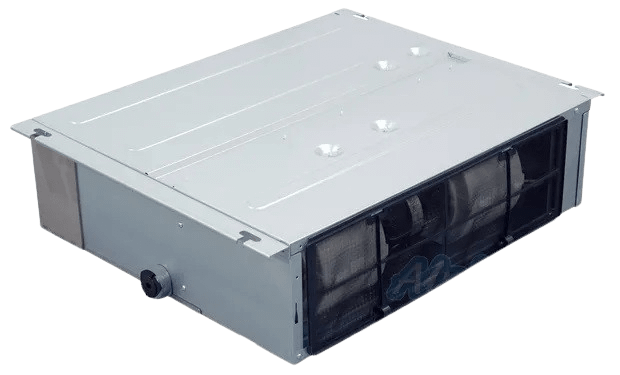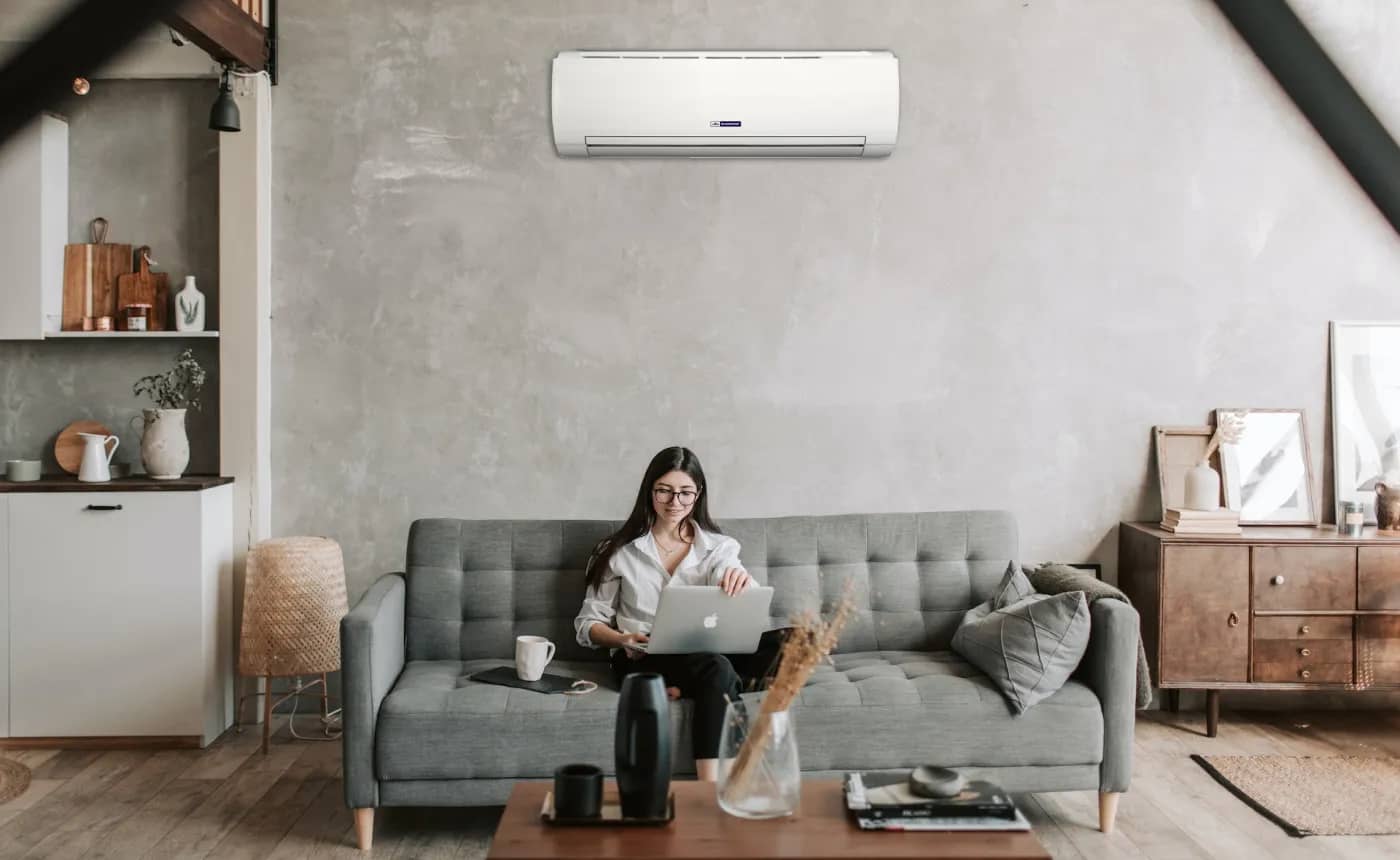
One of the biggest downsides to the typical wall-mounted mini-split system is that they’re too visible. Despite a mini-split’s proven benefits of greater efficiency and cost-savings over a traditional HVAC system, the look of a ductless indoor unit may be unappealing for some homeowners. Well, wait no more! A concealed duct mini-split is an ideal solution for anyone interested in a mini-split who prefers a more discreet heating and cooling option. Let’s explore why.
KEY TAKEAWAYS
- While ductless mini-splits have rapidly grown in popularity, concealed duct mini-splits provide another option for certain spaces.
- Concealed duct mini-splits use flexible ducts, making installation easier and allowing for multiple-room coverage that improves energy efficiency.
- Knowing the pros and cons of a concealed duct mini-split will help you decide if it’s the right heating and cooling system for you.
What is a Concealed Duct Mini-Split?
When exploring cooling and heating solutions for residential or commercial spaces, a concealed duct mini-split may emerge as a viable option, particularly for those seeking a subtle, non-intrusive system.
Also referred to as a hidden duct mini-split or ducted mini-split, this system operates like a typical ductless mini-split but has a different type of indoor unit.

Defining the Concealed Duct Mini-Split
A concealed duct mini-split system is an HVAC solution that combines the discrete aesthetic qualities of central air systems with the flexibility and efficiency of ductless mini-splits.
While it has the same basic components–an indoor air-handling unit and an outdoor condenser or heat pump—the type of indoor unit and its installation make it unique.
The indoor unit of a concealed duct system is typically installed in a centralized location within a drop ceiling, wall, attic, basement, or crawl space, leaving the system hidden from view.

Connected to a series of ducts, the indoor unit effectively distributes conditioned air to up to three rooms while remaining unseen.
Installation Specifics
The subtle, hidden installation is one of the major selling points of concealed duct mini-splits.
A ducted mini-split needs sufficient space in the chosen area to accommodate the indoor unit and its connecting ductwork. Installation often involves careful planning and execution to optimize air distribution while maintaining the unit’s low-profile presence.
Therefore, situating a ducted mini-split exactly where needed is a high priority to ensure efficient operation and uniform air distribution.
When to Opt for a Concealed Duct System
Choosing a concealed duct mini-split system could appeal in instances that prioritize maintaining aesthetic consistency and an unobtrusive HVAC presence, like some of the following situations:
Spaces with a Specific Aesthetic: High-end retail spaces, galleries, or historical buildings where visible units could detract from the visual appeal or historical accuracy might prefer this subtle option.
Open-Concept Living Areas: In some homes or buildings, the aesthetics of a space may be less important than simply not having the space. For example, a home with an open floor plan may have little wall space for a wall-mount-style unit. Though these floor plans are desirable for their airy, welcoming feel, they don’t allow for the practicality of a wall-mounted air handler.
New Constructions or Renovations: During the planning phase of a new building or renovation, integrating a concealed duct system might be easier since accommodations for the unit and ductwork can be incorporated into the design.
Multi-zone Applications: A multi-zone system with concealed duct units offers an elegant solution for larger spaces or environments where multiple room clusters need individual temperature control without installing visible units in each area.
Concealed duct mini-splits provide a perfect blend of the efficiency and comfort control of traditional mini-splits with a more integrated, less conspicuous presence within a space.
This makes it a notable contender when exploring HVAC options offering functional and aesthetic benefits.
Pros of Concealed Duct Mini-Splits
Understanding the distinct advantages of concealed duct mini-splits helps make informed decisions regarding HVAC installations in residential and commercial settings.
#1: Space Efficiency
Concealed duct mini-splits have the notable advantage of “short run” ducting, significantly enhancing space efficiency in any setting.
Unlike traditional whole-house ductwork systems, these specialized systems utilize compact, strategically placed ducts that neatly tuck into a ceiling, a floor, or an attic, eliminating the need for extensive, space-consuming ductwork.
Consequently, all the necessary components remain hidden, preserving and maintaining the aesthetic appeal of the room or space. This becomes especially critical in businesses, such as retail stores or restaurants, and homes where interior design might be a focal point, ensuring that the HVAC system does not intrude into the visual space.
#2: Flexible Ducting
The flexible ducting utilized in concealed duct mini-splits is another benefit for anyone who opts for this type of system.
Opposed to the rigid sheet metal used in the ductwork for a traditional central or forced air system, the flexible ducting used with concealed duct mini-splits can easily adapt to various structural configurations and constraints.
This flexibility makes for less labor-intensive installations and enables installers to navigate potential obstructions like beams or pipework, ensuring optimal airflow and system efficiency.
Additionally, this adaptability translates into more versatile installation options, accommodating various spatial and structural requirements and granting more creative freedom in the layout and design of spaces.
#3: Zoned Comfort
Zoned comfort is a pivotal advantage for concealed duct mini-splits.
With a multi-zone mini-split system (ducted or ductless), you can provide tailored heating and cooling solutions to different zones or areas of your home or office without installing an extensive ductwork system throughout the entire property.
Multi-zone mini splits allow independent regulation of each zone, allowing for customized temperature settings in different areas without affecting the overall system’s efficiency.
This increases the comfort level for all occupants and contributes to enhanced energy efficiency by focusing heating or cooling efforts where they are needed most and therefore preventing unnecessary energy usage in unoccupied or seldom-used zones.
Cons of Concealed Duct Mini-Splits
Although concealed duct mini-splits bring numerous benefits, it’s prudent to acknowledge and consider the drawbacks and challenges accompanying them.

#1: Complex Installation
Concealed duct systems, while advantageous in many ways, are considered one of the most complex and challenging mini-split types to install.
This complexity largely stems from the need to place these mini-split units inside homes designed without the hidden duct mini-split in mind.
Getting these units into a basement, ceiling, or attic can require substantially more work than simply installing wall-mount mini splits onto the walls of bedrooms, rooms, or office areas.
A contractor might be needed to assist, which may not appeal to those who enjoy DIY projects or want to save the extra money and do the installation themselves.

#2: Cost
Another pivotal aspect is the cost associated with concealed duct mini-split installations.
Generally, these systems carry a higher upfront cost due to the more complex installation and the need for specialized ductwork.
While this may be a financial con for some, it’s worth noting that operating a ductless mini-split will offset these initial costs in the long term through the system’s energy savings.
A hidden duct mini split has such efficient temperature control that this may curtail unnecessary energy expenditure, creating a balance over prolonged use.
However, prospective customers must weigh this long-term energy savings against the initial financial outlay to determine whether it’s viable for their context.

#3: Maintenance Considerations
When looking at performance and maintenance, concealed duct systems pose unique challenges that may make maintenance on these units more involved than a regular mini split heat pump.
For example, when you need to access a concealed duct system for maintenance or repair, the hidden nature of its installation can create additional work and potential difficulties.
Unlike wall-mounted units, which are readily accessible, concealed systems tuck away in ceilings or behind walls, which means that accessing them might require the removal of panels or parts of the ceiling.
Going Ductless? Then Go with Alpine!
When it comes to reliable and expert HVAC solutions, Alpine Home Air Products stands out as a beacon of trust and expertise in the industry.

Specializing in top-tier HVAC solutions, Alpine Home Air has made it a point to prioritize quality, reliability, and longevity in all our products, ensuring that your investment translates to a comfortable and efficient cooling and heating solution for your valued space.
When you’re in the market for a new HVAC solution or want to update an existing one, remember that Alpine’s trusted team of experts is simply an email or phone call away. We can’t wait to help!



